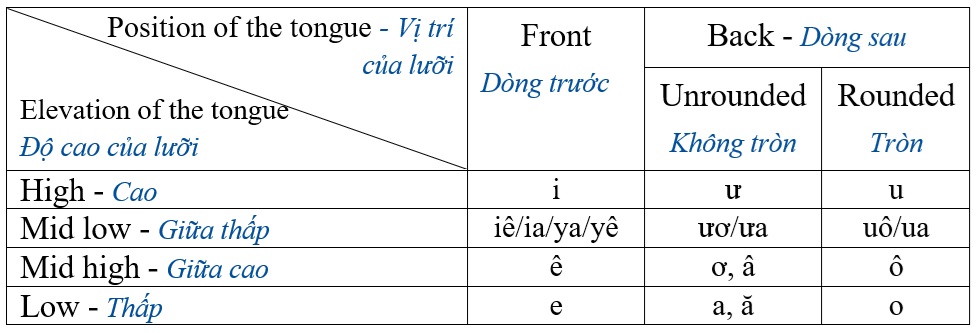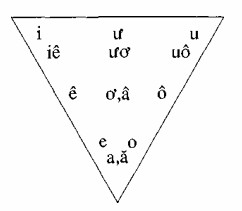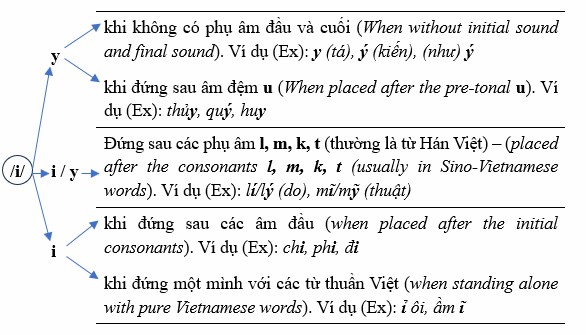BÀI 7. ÔN TẬP VỀ NGUYÊN ÂM
Review of vowels
Đặc điểm của nguyên âm trong âm tiết tiếng Việt
Characterisitcs of vowels in Vietnamese syllable
Vowels are a speech sound produced by human beings when the breath flows out through the mouth without being blocked by the teeth, tongue or lips:
Nguyên âm là âm thanh của lời nói được con người tạo ra khi hơi thở thoát ra bằng miệng mà không bị chặn bởi răng, lưỡi hoặc môi.
- A short vowel is a short sound as in the word:
Nguyên âm ngắn là âm ngắn như trong từ: “cup”.
- A long vowel is a long sound as in the word “shoe”.
Nguyên âm dài là một âm dài như trong từ “shoe”.
The vowel system in the Vietnamese language has eleven nuclei monophthong vowels: i, ê, e, ư, ơ, â, a, ă, u, ô, o and three nuclei diphthongs: iê (iê/ia/yê/ya), ươ (ươ/ưa), uô (uô/ua).
Hệ thống nguyên âm trong tiếng Việt có 11 nguyên âm đơn: i, ê, e, ư, ơ, â, a, ă, u, ô, o và ba nguyên âm đôi: iê (iê/ia/yê/ya), ươ (ươ/ưa), uô (uô/ua).
Vietnamese monophthongs equivalent to English are arranged as following chart - Nguyên âm tiếng Việt tương đương với tiếng Anh được sắp xếp như sau:
| No | Sound | Sounds like in English | Example in English | Example in Vietnamese |
| 1. | a [a] | /a:/ | in bank | ba (three) |
| 2. | ă [ᾰ] | /ʌ/ | hut | lăn (roll) |
| 3. | â [ɤˇ] | /ʌ/ | number | nấm (mushroom) |
| 4. | e [ε] | /e/ | end | kem (cream) |
| 5. | ê [e] | /e/, /æ/ | family | tên (name) |
| 6. | I [i] | /i:/ | city | gi (go) |
| 7. | o [ͻ] | /ɔ/ | long | to (big) |
| 8. | ô [o] | /ɔ:/ | ball | khô (dry) |
| 9. | ơ [ɤ] | /ə:/ | heard | tơ (silk) |
| 10. | u [u] | /u:/ | shoot | phun (eject) |
| 11. | ư [ɯ] | /ʊ/ | good | thư (letter) |
♦ The Position and elevation of the tongue are presented in the following chart - Vị trí và độ cao của lưỡi được thể hiện trong biểu đồ sau:

- The monophthongs can be front (i, ê, e), mid (ư, ơ, â, a, ă), and back (u, ô, o). Các nguyên âm dòng trước (i, ê, e), dòng giữa (ư, ơ, â, a, ă), dòng sau (u, ô, o).
- They can be high (i, ư, u), mid (ê, ơ, â, ô), and low (e, a, ă, o), depending on the extent to which the tongue rises in the direction of the palate.
Âm cao (i, ư, u), âm trung (ê, ơ, â, ô), âm trầm (e, a, ă, o), tùy theo lưỡi nâng lên theo hướng nào của vòm miệng.
- The lips are rounding when producing three rounded vowels u, ô, o and the diphthong uô/ua.
Môi tròn khi phát âm 3 nguyên âm tròn u, ô, o và nguyên âm đôi uô/ua.
- O is produced in a deeper position than ô, the mouth is open wider than in production of ô.
O được phát âm ở vị trí thấp hơn ô, miệng mở rộng hơn khi phát âm ô.
- Ô and u are rounded sounds. When pronouncing ô, the mouth is open wider than in producing u.
Ô và u là những âm tròn. Khi phát âm ô, miệng mở rộng hơn khi phát âm u.
- In the central position of the tongue, ư is the least open vowel, a is the most open vowel, and ơ is the half-open (or half-close) vowel.
Ở vị trí trung tâm của lưỡi, ư là nguyên âm ít mở nhất, a là nguyên âm mở nhất, ơ là nguyên âm nửa mở (hoặc nửa đóng).
- The difference between ê and e, and ô and o is based on the elevation of the tongue; that between u and ư is the lips rounded and unrounded.
Sự khác biệt giữa ê và e, ô và o là dựa vào độ cao của lưỡi; giữa u và ư là đôi môi tròn và không tròn.
|
♦ Triangle of vowels - Hình tam giác nguyên âm The nuclei vowels in Vietnamese are represented in the triangle on the basis of the part of the tongue that is raised and the position of the tongue toward the palate. Nguyên âm trong tiếng Việt được biểu diễn trong hình tam giác dựa trên phần lưỡi được nâng lên và vị trí của lưỡi hướng về vòm miệng. |
 |
♦ Lưu ý (Notes):
- How to write i and y in syllables in the two positions of main sound.
Cách viết i và y trong âm tiết ở vị trí âm chính.

- How to write the diphthongs iê, uô, ươ in Vietnamese syllables.
Cách viết các nguyên âm đôi iê, uô, ươ trong âm tiết tiếng Việt.
|
TT (No) |
Âm (sounds) |
Cách viết |
|
|
khi có âm cuối when followed by a final consonant |
khi không có âm cuối when not followed by a final consonant |
||
|
1. |
iê |
iê:tiền, miết, liên yê (theo sau - following u-): thuyền, chuyền |
ia: bia, chia, lia lịa ya (theo sau - following u-): khuya |
|
2. |
ươ |
ươ: mượn, tượng |
ưa: chưa, trưa |
|
3. |
uô |
uô: buồn, muốn |
ua: mua, chua, lúa |